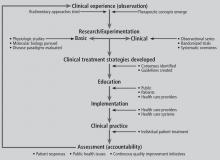Transplant innovation and ethical challenges: What have we learned?
A continued need for evidence-based guidance
By James B. Young, MD
Speaking as the lone internist on this panel, and also as a clinical trialist and evidence-based clinical practitioner, the greatest ethical challenge I see for transplantation is how to move the field forward in terms of garnering evidence that can help us treat patients and keep them alive. Nobody will deny that heart transplantation is life-saving therapy: my patients with end-stage ischemic cardiomyopathy can be dramatically transformed by a heart transplant after being near death. The questions now are how best to gain the data to guide the next round of innovations in transplant medicine and how to know when the time is right to attempt those innovations.
A HISTORICAL GLANCE AT HEART TRANSPLANTATION
Dr. Sharon Hunt, who was one of the first heart transplant cardiologists and worked with Dr. Norman Shumway, almost singlehandedly moved the field of cardiac transplantation forward. She recently chronicled its history,1 and this sort of historical review yields a couple of insights. First, fewer heart transplants are being done in the United States in this decade than in the 1990s,2 in large part because other effective interventions for heart failure have been developed. However, the number of heart transplants is in fact on the rise again.2 Second, survival rates in heart transplant have improved substantially in recent years compared with earlier eras, as documented by registry data from the International Society for Heart and Lung Transplantation.3
Among other things, we have learned how to improve the operation, better choose and preserve hearts, and better match hearts to recipients. We now can use hearts from older donors and allow older patients to undergo transplantation. One of the keys to the better survival rates is a dramatic change in the use of medications. Cyclosporine allowed for successful heart transplantation in the 1980s, and we have since seen the advent of agents such as tacrolimus, rapamycin, and mycophenolate mofetil. We rely less on the early immunosuppressants, such as prednisone and azathioprine.
Despite these successes from a survival standpoint, problems still need to be addressed. For instance, at 5 years, virtually every patient following a heart transplant develops hypertension and dyslipidemia, 1 in 3 has renal dysfunction (some requiring dialysis or transplant), 1 in 3 has diabetes, and some develop a strange allograft arteriopathy.3
THE CHALLENGE OF EVALUATING A BOUTIQUE SCIENCE
Heart transplantation is a bit of a boutique science. Although relatively few heart transplants are performed compared with liver or kidney transplants, heart transplantation is a dramatic operation limited by many ethical challenges surrounding organ donor supply and utilization.
As for any boutique science, questions arise about how to evaluate it with the rigor of regulatory authority—from both the Food and Drug Administration (FDA) perspective and the institutional review board (IRB) perspective—without large clinical trials. Suppose that Dr. Cooley wants to make a minor modification in his immunosuppressive protocol because of an observation of a high incidence of renal failure at the 5-year point; does that ethically demand a large randomized clinical trial?
How can we design clinical trials to help determine which direction to take in immunosuppression intensification or utilization protocols? Other challenges include evaluating outcomes (such as coronary artery vasculopathy) from databases, and then figuring out good and bad practices. For example, databases show us that a donor history of diabetes increases the recipient’s long-term risk of developing coronary artery vasculopathy.3 Receiving a heart from a male donor also increases risk.3 Better understanding the panoply of adverse events and what leads to better outcomes will give us a sense of how to proceed and can drive the design of clinical trials.
OTHER ETHICAL CHALLENGES
From an ethical standpoint, how do we change practice? We have data on outcomes at 5, 10, and even 20 years. The half-life of a heart transplanted today is 12.5 years, whereas it used to be about 7 years.3 Although it is clear that we have made progress, it is a challenge to determine exactly how to make subtle changes in practice, such as addressing polypharmacy post-transplant.
Developing schemes that enable major innovation, particularly through coordination among medical and surgical teams, is another challenge. For example, we are working with preservation techniques that use a beating heart for transplantation. From solid evidence based on animal models, we believe this preparation can allow preservation of a heart for up to 12 hours. To some, that may beg a number of questions: Why do we need to do a clinical trial in humans? Why does the FDA need to regulate us? Why do we even need to answer to an IRB? Why not just make the change to alleviate the problem of donor organ supply?







